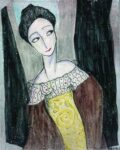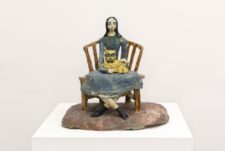
Beatrice Wood
American, 1893-1998
Untitled (Helen Freeman), 1938-39
glazed ceramic
5 1/2 x 3 3/4 x 2 7/8 in.
SBMA, Gift of Francis M. Naumann
1997.57.3

Beatrice Wood, Self-portrait, 1954
“And then, of course, most potters, they go in for earth tones and subdued things, and I like color.” - Beatrice Wood

Beatrice Wood - Not Married, c. 1965, stoneware or earthenware, glaze
COMMENTS
Wood, often affectionately known as Beato or the “Mama of Dada”, made significant contributions to the avant-garde, and Dada movements, as well as the rich history of American ceramics. In the early 1900s, Wood immersed herself in the New York scene, befriending artists such as Marcel Duchamp, Francis Picabia, Man Ray and others, exhibiting her own artwork for the first time in 1917. Wood moved to California in the 1930s, where she would spend the rest of her life, and began making ceramics under the mentorship of Getrude and Otto Natzler, eventually developing her own signature style and glazing techniques.
While Wood’s ceramic works would garner international acclaim by the 1970s, she maintained a nearly daily practice of drawing throughout her life, which was used as a vehicle to explore the female form, sexuality, and desire. Dating from the 1920s through the 1990s, the drawings included in the gallery’s presentation demonstrate their diaristic quality, depicting Wood’s relationships, dreams, and politics, often with a humorous bent. These characteristics carry over to Wood’s figurative sculptures, which were developed by Wood in a near-defiance of the technical mastery of her ceramic works. Often dismissed as naive, or “folk” by the ceramics community during her lifetime, these seminal works offered a window into the growing pessimism Wood felt towards her own sexual relationships. Works such as “Not Married”, c. 1965, which depicts a woman seated with a cat on her lap, functions as a self-portrait and takes on an almost self-effacing tone. In using this near-typified depiction of a “spinster”, and adopting it as her own avatar, Wood incisively takes on the traditional roles available to women at the time. In doing so, Wood sought to dismantle them, as demonstrated by the bohemian, and independent character that defined her own life.
- Andrew Kreps Gallery, 2021
http://www.andrewkreps.com/attachment/en/59bff84cdca83743488b4567/TextOneColumnWithFile/605b3d54e47d853eed470427
SBMA CURATORIAL LABELS
Like miniature toppers for a wedding cake, the figurines in both versions of Untitled (Beatrice Wood and Steve Hoag) depict the artist and her second husband on the occasion of their Las Vegas wedding. Their elongated, languid bodies drift in different directions, gesturing towards an emotional disconnect. But a juvenile-like awkwardness allows the scene to be humorous rather than tragic. In real life, they had a marriage of convenience that remained unconsummated. Alternatively, the figure of Helen Freeman, Wood’s traveling companion and friend, is intimate and sensual. She is nude, and her lips are the most prominent feature on her face. As a group, these biographical works suggest the artist’s longing for passion outside the confines of domestic partnership.
- WARES! Extraordinary Ceramics and the Ordinary Home, 2023
